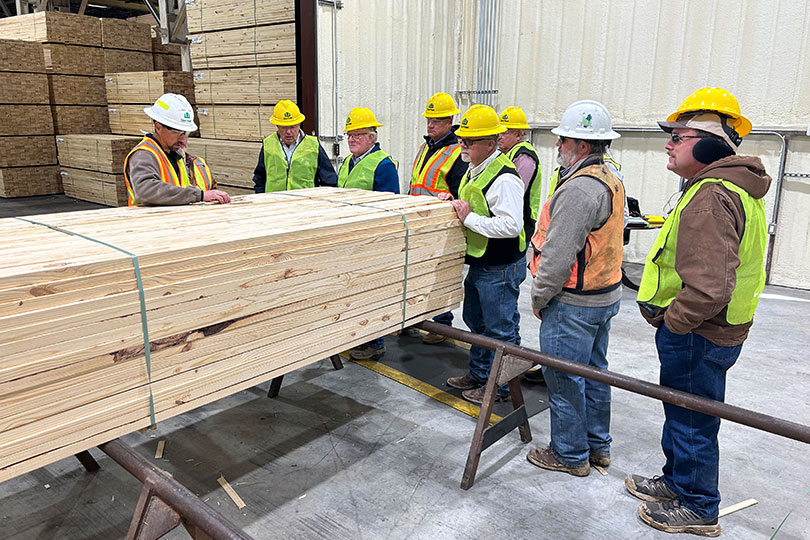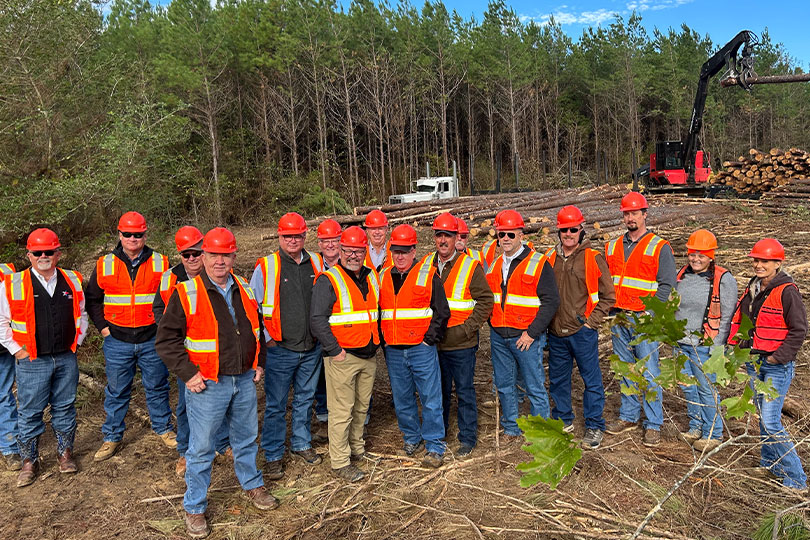By Julie Tomascik
Editor
In East Texas, tall, tall trees stretch to the sky and are cared for by timber farmers and foresters. But the forestry industry extends beyond the farm.
East Texas is also home to several sawmills and lumber companies that fuel the local and state economy.
Last month, Angelina County Farm Bureau hosted a tour for Texas Farm Bureau’s (TFB) board of directors. They toured a logging site, sawmill, particleboard mill and an oriented strand board (OSB) mill to gain a better understanding of East Texas timber production.
Harvested timber ranks seventh among the state’s top agricultural commodities, and the forest-based industry was one of the top 10 manufacturing sectors in the state, according to the Texas Forest Service.
“Forestry drives a large part of our economy. It ranges all the way from the planters who plant the seedlings to the equipment operators who clean the land after it’s been clear cut to the loggers,” Cody Berry, Angelina County Farm Bureau board member, said. “You have contractors who work with the private landowners, and you have truck drivers who get the product to the mills. Plus, you have the employees at the mills who make all the products that are then shipped to retailers across the state and nation.”
For TFB District 1 State Director Pat McDowell, East Texas looks much different than the Panhandle where he calls home.
“It’s very different from the Panhandle, but those farmers have the same business concept,” McDowell said. “They’re growing a crop. It may take 20 to 25 years to grow, but they do it.”
They face similar challenges, too.
“They have weather problems. They have market problems. They have government problems—just like we face in our business of raising cattle and growing crops,” he said.
East Texas has suffered through extreme drought conditions much like the rest of the state. The prolonged dry conditions have an effect on tree growth and structure.
“We have shrink and swell cycles, and that causes some ground movement at the base of the tree, which doesn’t sound like a big deal,” Berry said. “But when you have a tree that has a slight crook or bend in it, that decreases the value of the tree. So, drought does have an effect on that because when the ground swells or shrinks, that leaves room for the tree trunk to adjust and move and shift in the growth range.”
Timber farmers also lost trees to the drought. Last year’s dry conditions, followed by a wet winter and another summer of drought, stressed the trees.
“That’s crop loss. That’s just like losing a cotton or a corn crop to drought,” Berry said. “The trees die, and now you’ve lost between five to 25 years of time on that one tree, and the profit is gone.”

On the tour, they visited mills and processing facilities to see how the trees are transformed into products consumers use every day.
“It’s important to go visit with people who do something different,” McDowell said. “Seeing the way they work with their different suppliers and how they market their products—it’s an eye-opening experience.”
Angelina County Farm Bureau hosted another tour earlier this year to give the U.S. House Agriculture Committee members a look at the forestry industry.
“It’s important to bring groups out to East Texas to see how intensive and how important it is for foresters to manage the timber crop,” Berry said. “A lot of work goes into the forestry industry from growing trees and making lumber products.”

